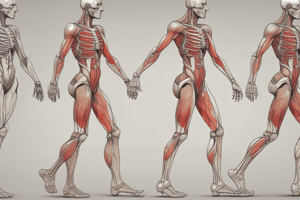Podcast
Questions and Answers
What is the primary role of the Iliopsoas muscle?
What is the primary role of the Iliopsoas muscle?
- Rotation of the hip
- Flexion of the hip (correct)
- Extension of the hip
- Abduction of the hip
Where does the origin of the Gluteus Maximus (Grand Fessier) muscle occur?
Where does the origin of the Gluteus Maximus (Grand Fessier) muscle occur?
- Lumbar vertebrae
- Pelvis (correct)
- Pubis
- Iliac crest
Which muscle is responsible for stabilizing the pelvis?
Which muscle is responsible for stabilizing the pelvis?
- Tensor fascia lata (correct)
- Sartorius
- Quadriceps
- Iliopsoas
What is the termination point of the Quadriceps muscle?
What is the termination point of the Quadriceps muscle?
Which of the following roles is NOT associated with the Ischio-Jambier group of muscles?
Which of the following roles is NOT associated with the Ischio-Jambier group of muscles?
Which of the following muscles is classified as an external rotator of the hip?
Which of the following muscles is classified as an external rotator of the hip?
What action does the Gastrocnemius primarily facilitate?
What action does the Gastrocnemius primarily facilitate?
Which statement regarding the Sartorius muscle is accurate?
Which statement regarding the Sartorius muscle is accurate?
Flashcards
What is the Iliopsoas muscle and what does it do?
What is the Iliopsoas muscle and what does it do?
Iliopsoas is a large muscle group located in the front of the hip. It originates from the lumbar spine (lower back) and attaches to the femur (thigh bone). Its primary function is to flex the hip joint, allowing for activities like bringing your knee up towards your chest or bending over.
What is the Gluteus Medius and what does it do?
What is the Gluteus Medius and what does it do?
The gluteus medius is a large muscle positioned on the side of the hip. It originates from the iliac crest (upper part of the pelvis) and inserts into the femur. Its main responsibility is to abduct the hip joint, which means moving the leg away from the midline of the body.
What is the Gluteus Minimus and what does it do?
What is the Gluteus Minimus and what does it do?
The gluteus minimus is a smaller muscle located beneath the gluteus medius. It also originates from the pelvis and inserts into the femur, and its main function is to abduct the hip joint.
What is the Tensor Fascia Lata and what does it do?
What is the Tensor Fascia Lata and what does it do?
Signup and view all the flashcards
What is the quadriceps femoris and what does it do?
What is the quadriceps femoris and what does it do?
Signup and view all the flashcards
What are the hamstrings and what do they do?
What are the hamstrings and what do they do?
Signup and view all the flashcards
What is the sartorius muscle and what does it do?
What is the sartorius muscle and what does it do?
Signup and view all the flashcards
What is the popliteus muscle and what does it do?
What is the popliteus muscle and what does it do?
Signup and view all the flashcards
Study Notes
Lower Limb Muscles
-
Ilio-Psoas:
- Origin: Lumbar region
- Insertion: Femur
- Action: Hip flexion
-
Middle Gluteus (Gluteus Medius):
- Origin: Iliac crest
- Insertion: Femur
- Action: Hip abduction
-
Small Gluteus (Gluteus Minimus):
- Origin: Pelvis
- Insertion: Femur
- Action: Hip abduction
-
Tensor Fascia Latae:
- Origin: Ilium
- Insertion: Femur
- Action: Hip stabilization
-
Pelvitrochanteric:
- Origin: Pelvis
- Insertion: Femur
- Action: Hip external rotation
-
Gluteus Maximus:
- Origin: Pelvis
- Insertion: Femur
- Action: Hip extension
-
Adductors:
- Origin: Pubis
- Insertion: Femur
- Action: Hip adduction/flexion
Knee Muscles
-
Quadriceps:
- Origin: Four muscle heads (rectus femoris, vastus lateralis, vastus medialis, vastus intermedius)
- Insertion: Tibia via patella
- Action: Knee extension / hip extension
-
Sartorius:
- Origin: Ilium
- Insertion: Proximal tibia
- Action: Hip flexion/adduction, knee flexion
-
Hamstring (Biceps Femoris, Semitendinosus, Semimembranosus):
- Origin: Pelvis
- Insertion: Tibia
- Action: Knee flexion/ hip extension
-
Popliteus:
- Origin: Lateral Femur
- Insertion: Posterior Tibia
- Action: Knee flexion
Ankle/Foot Muscles
-
Gastrocnemius:
- Origin: Femur
- Insertion: Calcaneus via Achilles tendon
- Action: Knee flexion/ankle plantar flexion
-
Soleus:
- Origin: Tibia/fibula
- Insertion: Calcaneus via Achilles tendon
- Action: Ankle plantar flexion
-
Tibialis Anterior:
- Origin: Tibia
- Insertion: Metatarsals
- Action: Ankle dorsiflexion
Trunk Muscles
- Abdominals:
- Composed of 5 abdominal muscles (Rectus abdominis, External Oblique, Internal Oblique, Transverse Abdominis, Quadratus Lumborum)
- Action: Trunk stabilization, respiration
Studying That Suits You
Use AI to generate personalized quizzes and flashcards to suit your learning preferences.




